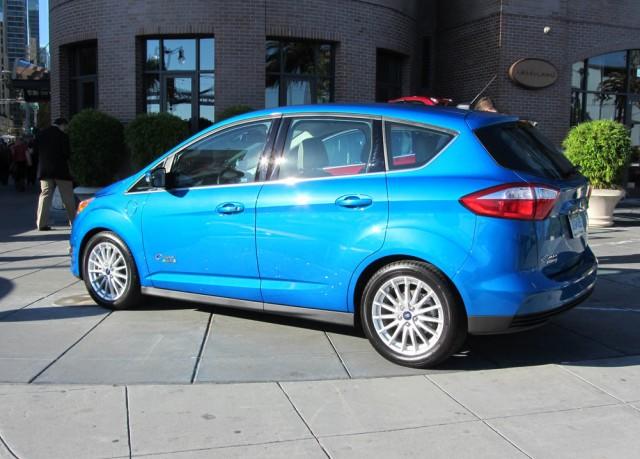Get past their odd names and you may find that the 2013 Ford C-Max and its sister C-Max Energi are surprisingly good hybrid crossover vehicles.
New for 2013, the C-Max/C-Max Energi front-drive, four-door compact hatchbacks are virtually unchanged for 2014. They’re designed to directly compete with the top-selling Toyota Prius and seat five, although the center of the rear seat of the C-Max Energi I tested is too stiff for longer trips.
The C-Max and C-Max Energi use a two-liter four-cylinder gas engine and electric motor. Both have a combined 188-horsepower rating, which gives them lively acceleration and good highway performance, although they’re rather heavy.

The transition between electric and battery power is seamless. Both use a smooth CVT automatic transmission.
The main difference between the C-Max and C-Max Energi is that the C-Max is a gas/electric hybrid, while the C-Max Energi is a gas/electric hybrid that calls for a battery plug-in, using a standard 120-volt outlet or a 240-volt charging station.
The 2013 C-Max lists at $25,200-$28,365, while the Energi costs $32,950. Those prices don’t include a $795 destination charge.
All versions are well equipped with comfort, convenience and safety equipment—unlike some gas-electric or battery-only cars. We’re talking about everything from multi-zone automatic air conditioning, cruise control, keyless entry and power windows and mirrors. The higher-line $28,365 SEL hybrid adds a power driver seat, heated front leather seats, rear parking aid and keyless start.
The C-Max reportedly can travel on full-electric mode for about 20 miles at speeds below 62 m.p.h. The Energi plug-in version can travel on eclectic power alone for about 20 miles at speeds up to 60 m.p.h.

Those, at least, are the claims. As with any electric car, much depends on how aggressively the C-Max and C-Max Energi are driven (no jack-rabbit starts!), cold temperatures, number of power-draining accessories used, etc.
The C-Max Energi, which I tested, reportedly has an overall range of 500 miles. But figuring out fuel economy and driving range with gas/electric hybrids is a headache. For instance, the price sticker on the C-Max Energi says it’s estimated to get 43 miles per gallon “on gasoline only,” but the car’s computer only read 37 miles per gallon during fairly average driving, using battery and gas power. Some hybrid electric car buyers have complained about optimistic EPA fuel-economy ratings.
The C-Max is acceptably styled, with a low, aggressive-looking front end that distinguishes it—not that it could be easily found in a large, crowded parking lot. All doors open wide to reveal a nicely finished, quiet interior. Front seats offer good side support, although tall drivers may feel they need more thigh support. And one wonders why there are twin lights on each sun visor if the car is designed to conserve every bit of electricity.
The backlit gauges can be easily read, and there’s a range of instruments related to the electric power system that some will find interesting to glance at—at least initially. Mainly, I suspect drivers likely will be most interested in the miles-per-gallon reading.
Front console cupholders are handy, and there is a seemingly bottomless covered storage bin on the console. All doors have storage pockets. A fold-down center rear armrest contains dual cupholders.
My test car’s $3,080 option group contained items including a handy power hatch, rearview camera, parking technology package and automatic parking. There’s also an $1,195 panoramic sunroof.
The power electric steering is firm, but accurate and feels reassuring. The C-Max Energi tracked well at highway speeds. Handling was agile, although the car’s weight could be felt in sweeping curves and during quick maneuvers. Traction and stability controls help keep things on an even keel when moving quickly through curves.
The ride is supple. And the brakes stop the car quickly, but feel a little touchy due to a regenerative braking system that helps fuel economy. Apply the brakes and a driver sees symbols on a dashboard diagram that let him know the system is working.
Forget regular cargo space with the C-Max Energi, as the batteries consume nearly all trunk room. However, the 60/40 split rear seatbacks fold flat, forming a large cargo area.
A prop rod holds the heavy lined hood open, if one dares mess with any of the under-hood electronics. However, fluid-filler areas can be easily reached.
While the C-Max/C-Max Energi is primarily a practical car, it’s enjoyable to drive and a nice piece of automotive engineering.
Pros: Good fuel economy. Quick. Agile. Supple ride. Generally roomy.
Cons: Energi version needs battery plug-in. Fold-down seatbacks needed for decent Energi cargo room.
Bottom Line: Generally satisfying Euro-style hybrid crossover.
Dan Jedlicka has been an automotive journalist for more the 40 years. To read more of his new and vintage car reviews, visit: www.danjedlicka.com.
Article Last Updated: April 22, 2014.
- About the Author
- Latest Posts
An automotive journalist who has reviewed more than 4,000 vehicles in a nearly 45-year career, Dan is publisher of DanJedlicka.com.






